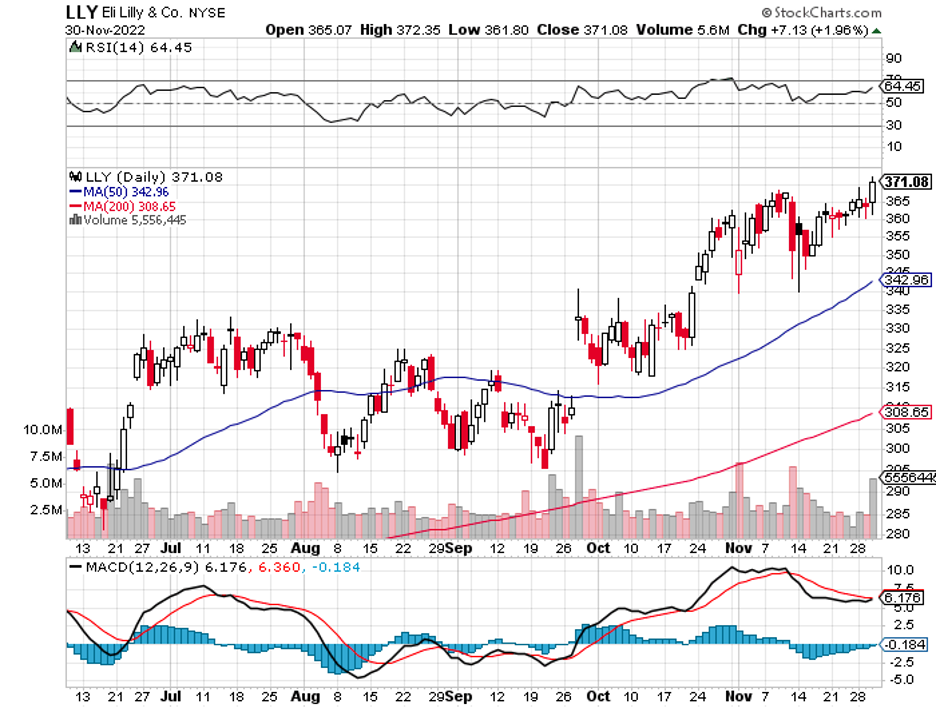Whispers of a recession in 2023 plague virtually every corner of the world. Nowadays, fund managers and Wall Street leaders are developing strategies to brace themselves for what’s to come next.
Inflation continues to be a cause of alarm, and a more unstable growth backdrop not only in the United States but also across the globe could drag down earnings in almost all industries. That means tactics to play defense are all the rage these days.
With the market meltdown this year, several names in the biotechnology and healthcare industry managed to buck the trend and even rise significantly. One of them is Eli Lilly (LLY).
Eli Lilly has surged by 33% in 2022 and continues to outperform the market amid the economic turmoils and financial crises; let’s check out what’s under its hood and see if it’s a good stock to add to a recession-proof portfolio.
Although it wasn’t the major player in the recent updates on Alzheimer’s disease treatments, Eli Lilly shares rose following the announcement from Eisai (ESALY) and Biogen (BIIB) earlier this week.
The full results of their Phase 3 trials showed promising data, which strengthened the underlying theory that Alzheimer’s symptoms are linked to the beta-amyloid plaques that build up in the patient’s brain.
While this theory has been floating around for roughly 30 years, Biogen’s study marks the first time it received any confirmation. The results convincingly illustrated the link between eliminating the amyloid and the slowdown in cognitive decline among Alzheimer’s patients.
Biogen and Eisai may be the first to prove this, but their work provided Eli Lilly’s Alzheimer’s program the much-needed boost since the latter’s candidates are also based on the same theory.
In terms of revenue, Eli Lilly and Biogen could compete for a market opportunity worth more than $20 billion.
Outside this Alzheimer’s program, Eli Lilly offers investors a top-notch and diverse portfolio.
Founded way back in 1876, the company has grown into the second-biggest pharmaceutical business across the globe. It has a market capitalization of $343 billion, which is next only to Johnson & Johnson, with $459 billion.
The leading candidate in Eli Lilly’s portfolio is its Type 2 diabetes drug, Trulicity, which rakes in over $5 billion in sales annually. On top of that, it has 6 more blockbusters contributing more than $1 billion in annual revenue. These include the cancer drug Verzenio, insulin treatments Humalog and Humulin, and heart failure medication Jardiance.
These products, along with 9 other drugs in Eli Lilly’s portfolio, all contributed to boosting its revenue by 2.5% year-over-year to reach $6.9 billion in the third quarter of 2022. It also helps that the company has an expansive presence worldwide, with its treatments and products available in 120 countries.
There are also approximately 70 more projects queued for clinical development, while others are awaiting regulatory review.
Meanwhile, the most significant catalyst for Eli Lilly this year has been its Type 2 diabetes drug Mounjaro, which was approved last May.
The recently concluded third quarter marked the first complete quarter since the drug was launched in the US. Raking in an impressive $97.3 million in revenue for this period alone, Mounjaro is definitely off to a promising start.
The figures are projected to climb as Eli Lilly receives regulatory approvals from Japan and the European Union.
Actually, Mounjaro is anticipated to become a mega-blockbuster drug for Eli Lilly. It’s estimated to reach annual peak sales of $25 billion. For context, this amount is almost as much as the total revenue of the company in 2022, which is $28.6 billion.
Overall, they have consistently proved as one of the best-managed biopharmaceutical companies in the world. Its innovative strategies and initiatives have been top-notch. Eli Lilly is a stock worthy of a spot in a recession-proof portfolio. Make sure to buy the dip.

